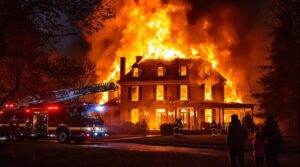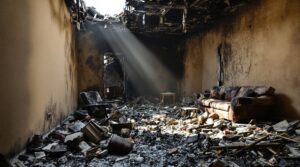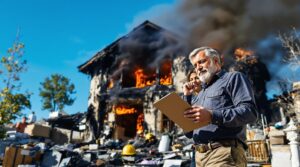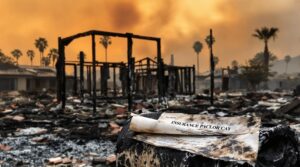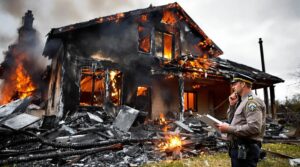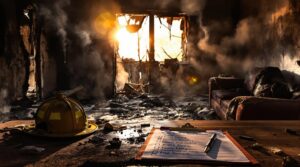Managing fire damage insurance claims requires understanding policy coverage, procedures, and essential steps to take after a fire. Effective documentation of damage and securing property from further damage are vital. Policyholders must understand the details of their insurance policy to maximize claim settlements.
Dealing with claim denials and delays can be challenging, but professional estimates and hiring a public adjuster can aid in the process. By exploring these key elements, individuals can better equip themselves to handle the complexities of fire damage insurance claims.
Key Takeaways
- Familiarize yourself with insurance policy terms, including limits, exclusions, and covered perils, to navigate the claims process efficiently.
- Immediately secure the property, document damage, and notify the insurance company after a fire to initiate the claims process.
- Thoroughly document damage with photos, videos, and inventory lists, and maintain organized records of correspondence with the adjuster.
- Consider hiring a public adjuster to identify eligible losses, negotiate fair settlements, and reduce stress throughout the claims process.
- Accurately assess and report fire damage losses, addressing common challenges, such as undervaluation and claim denials, to achieve maximum settlement.
Understanding Fire Damage Insurance Coverage
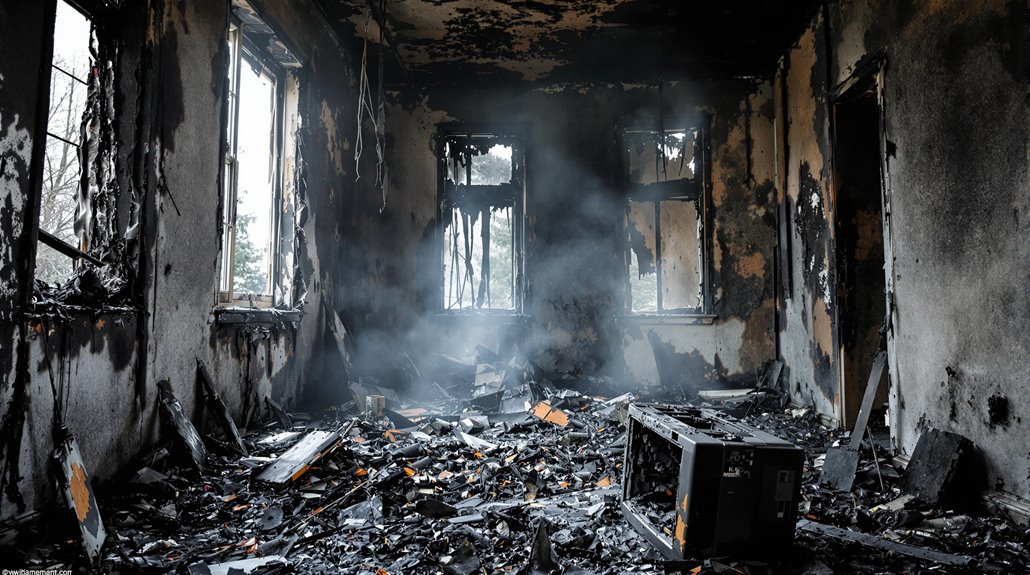
As an indispensable component of managing fire damage insurance claims, understanding the nuances of fire damage insurance coverage is essential for homeowners seeking to recover losses in the event of a fire. A thorough understanding of one’s insurance policy is essential.
Fire damage insurance coverage includes dwelling coverage, which protects the home’s physical structure, and personal property coverage, which assists in replacing household items and belongings lost or damaged due to fire. Homeowners must know policy limits, exclusions, and covered perils, including distinctions between open and named peril terms.
Familiarity with these key aspects of coverage enables policyholders to effectively navigate the claims process and guarantee they receive fair compensation for their losses. Understanding your insurance policy is crucial. Working with state-licensed public adjusters can significantly increase the likelihood of receiving higher claim settlements than managing the process independently.
Essential Steps To Take Immediately After A Fire
When a fire occurs, prioritizing the safety of all individuals involved is paramount. Ensuring everyone’s safety and evacuating if necessary while contacting emergency services to report the fire is vital. It is essential to notify your insurance company when it is safe.
Retaining essential documents, such as receipts related to expenses incurred due to the fire, will facilitate the fire damage restoration process. Consulting with a public insurance adjuster can provide valuable expertise in maximizing your settlement and navigating complex policy terms.
| Immediate Steps | Purpose | Action Items |
|---|---|---|
| Secure the Property | Prevent Further Damage | Board up broken windows and doors, apply tarps to damaged roofs |
| Document the Damage | Record Extent of Loss | Take extensive photos and videos, create a detailed inventory of damaged items |
| Notify Insurance Company | Initiate Claims Process | Provide policy number and brief incident description, retain important documents |
Documenting Fire Damage Effectively
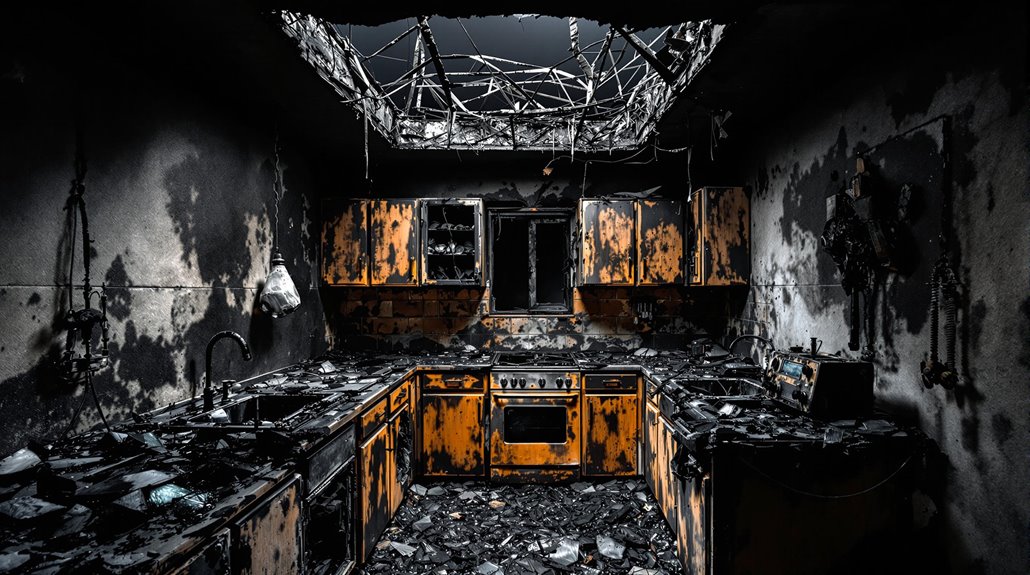
Thorough documentation is essential in the aftermath of a fire, as it provides crucial evidence to support a fire damage insurance claim. Documenting fire damage effectively requires capturing extensive photos and videos of all damage to the structure, including wide-angle views and close-ups.
A detailed inventory list of damaged items should also be created, including descriptions, estimated values, and purchase dates. This documentation should be supplemented with receipts, warranties, and old photos to prove the existence and condition of personal property before the fire occurred.
Hidden damage, such as water, smoke, and soot, should be documented, as they can significantly impact air quality. This thorough documentation will help guarantee a smooth and successful insurance claim process. Working with public insurance adjusters can help maximize your settlement and ensure all damages are properly documented and valued.
Securing Your Property From Further Damage
Following the thorough documentation of fire damage, property owners must take immediate action to secure their property from further damage. This involves preventing unauthorized access, mitigating water damage, and protecting valuable items that survived the fire.
- Board up broken windows and doors with plywood to prevent further weather damage and unauthorized access.
- Use tarps to cover damaged roofs or exposed areas to mitigate water damage from rain and prevent additional structural issues.
- Secure valuable items by removing them from the property and storing them safely to avoid further loss.
Documenting all security measures taken with photographs and receipts is essential to provide evidence for the insurance claim process. This helps guarantee a smoother and more efficient recovery phase.
Understanding Your Insurance Policy Details
While traversing the complexities of a fire damage insurance claim, property owners must have an extensive understanding of their insurance policy details. Familiarizing oneself with the coverage options, limitations, and exclusions is critical for guiding the claims process effectively. Understanding the specific details of one’s insurance policy can guarantee adequate protection against fire-related losses.
| Coverage Type | Description |
|---|---|
| Dwelling (A) | Protects physical home structure from fire damage |
| Other Structures (B) | Includes detached structures like garages and sheds |
| Personal Property (C) | Replaces damaged belongings, may be named or open peril coverage |
It is also essential to recognize the deductible amounts and potential limitations that may affect the claims process. A thorough comprehension of the insurance policy is fundamental for a smoother and more efficient recovery from fire damage. Actual cash value calculations can significantly impact the final payout amounts compared to replacement cost coverage.
Filing Your Fire Damage Insurance Claim
As the initial step in recovering from a fire, filing a fire damage insurance claim promptly and accurately ensures that the claims process unfolds efficiently. To initiate the process, the policyholder should contact their insurance company immediately after the fire, providing their policy number and a brief description of the incident.
The following key steps should be taken when filing fire damage claims:
- Document all damages thoroughly with photographs, videos, and a detailed inventory list of damaged items, including estimated values and purchase dates.
- Understand the specific timeframes outlined in the policy for reporting claims to avoid complications or denial of coverage.
- Prepare to provide the insurance adjuster with all necessary documentation, including receipts for repairs and temporary housing expenses.
Consider hiring a public adjuster to advocate exclusively for your interests and ensure you receive the maximum settlement possible under your policy.
Communicating With Your Insurance Adjuster

How effectively does a policyholder communicate with their insurance adjuster after a fire? Effective communication is essential in facilitating a smooth claims process. To achieve this, policyholders should maintain a professional and courteous demeanor when interacting with the adjuster.
They should also be prepared to provide detailed documentation of all damages, including photos and inventory lists, to support their claims. Keeping meticulous records of all interactions with the adjuster, including dates, times, and key points discussed, guarantees clarity and accountability. By focusing on factual details relevant to the claim and avoiding unnecessary personal information, policyholders can prevent misunderstandings.
Clear communication can ultimately lead to a fair settlement, and policyholders have the right to discuss unsatisfactory offers with a public adjuster or attorney for further evaluation. Since insurance adjusters often prioritize profit-driven assessments, policyholders should be prepared to justify and defend their damage claims with substantial evidence thoroughly.
The Role of Adjusters in Fire Damage Claims
In the aftermath of a fire, the role of insurance adjusters becomes essential in evaluating and determining the extent of damage to a policyholder’s property. Insurance adjusters are responsible for appraising the damage and estimating the costs of repairs and replacements. They conduct thorough inspections, documenting structural damage, smoke damage, and content loss.
Key responsibilities of insurance adjusters include:
- Conducting on-site inspections to evaluate the damage and estimate the costs of repairs and replacements
- Reviewing and verifying documentation, including inventories of damaged items, photographs, and receipts
- Serving as intermediaries between policyholders and insurance companies to guarantee fair and prompt settlements, and negotiate settlements when disputes arise
Maintaining state-specific licensing requirements ensures adjusters stay current with regulations while providing accurate damage assessments for fire claims.
Navigating the Claims Process

Policyholders who have experienced a fire must navigate the complex claims process to obtain fair compensation for their losses. To initiate the process, contact the insurance company promptly to report the incident and gather the necessary documentation. A claims adjuster will assess the damage.
Maintaining accurate documentation and open communication with the adjuster facilitates a smoother process. Consider seeking assistance from a public adjuster if disputes arise. Keeping track of policy coverage limits is essential for receiving fair compensation. Effective communication strategies between homeowners and insurance providers can reduce claim processing delays significantly.
| Action | Description |
|---|---|
| Initiate Claim | Contact the insurance company to report the incident |
| Document Losses | Meticulously record damage with photographs, videos, and inventory lists |
| Communicate with Adjuster | Maintain organized records of all correspondence |
| Review Coverage | Be aware of the policy’s coverage limits and exclusions |
Tracking Additional Living Expenses (ALE)
Numerous expenses arise when a home is rendered uninhabitable due to fire damage, and Additional Living Expenses (ALE) coverage is designed to reimburse policyholders for these necessary costs. To guarantee proper reimbursement, it is vital to track these expenses diligently.
- Keep receipts and invoices for all additional living expenses, including temporary housing, meals, and other essential living expenses.
- Maintain a log of expenses, including dates and descriptions, to provide a detailed account of daily living costs.
- Understand the ALE limits outlined in your insurance policy, as they determine the maximum amount you can claim for additional living expenses during recovery.
Many homeowners overlook that liability coverage extends to temporary housing situations during displacement from fire damage.
Common Challenges In Fire Damage Claims

Many fire damage claims are complicated by challenges that can hinder the recovery process for affected property owners. These challenges often involve disputes with insurance adjusters, claim denials, and extensive documentation requirements. For example, wildfire damage claims require specialized documentation and detailed proof of loss, according to most insurance providers. Additionally, property owners may find themselves struggling to navigate the complex terms of their insurance policies, which can vary widely from one provider to another. This uncertainty can lead to frustration and delays in receiving the necessary funds for repairs. To aid in this process, it is helpful to seek out expert advice or resources that provide tips for filing fire insurance claims, ensuring that all necessary information is presented accurately and promptly.
These challenges can result in delayed or reduced settlements, exacerbating the emotional stress experienced by property owners following a fire incident.
| Challenge | Impact on Claims Process |
|---|---|
| Undervaluation by insurance adjusters | Insufficient compensation for repairs and replacements |
| Disputes over policy coverage | Complicated claims process and potential denials |
| Claim denials due to intentional fire or safety neglect | Jeopardized coverage eligibility |
| Extensive documentation requirements | Overwhelming policyholders, leading to claim denials |
| Emotional stress following a fire incident | Hindered ability to navigate the claims process, leading to delays or miscommunication |
Dealing With Claim Denials & Delays
When guiding through the fire damage insurance claims process, claim denials and delays can significantly hinder a property owner’s recovery efforts. Claim denials may occur due to insufficient coverage, damage assessment disputes, or policy limit discrepancies. To resolve such issues, diligent documentation of losses and open communication with the insurance adjuster is essential.
Some steps to reflect upon when dealing with claim denials and delays include:
- Requesting a detailed explanation from the insurance company for the claim denial and reviewing the policy to understand the justification
- Providing additional documentation or clarifying discrepancies to facilitate the resolution process with the insurance adjuster
- Seeking professional assistance from a public adjuster or legal expert if denials persist or appeals are necessary to protect policyholder rights.
Studies indicate that policyholders working with licensed public adjusters typically receive settlements up to 500% higher for non-catastrophic claims compared to those handling claims independently.
Tips For Maximizing Your Claim Settlement

To maximize a claim settlement effectively, understanding the intricacies of the insurance policy and documenting losses meticulously are essential steps in the recovery process. In managing fire insurance claims, thorough documentation of all fire damage is crucial. This includes taking extensive photos, videos, and creating a detailed inventory list of damaged items, complete with descriptions and estimated values.
A public adjuster can also be hired to advocate on the policyholder’s behalf, assist with complex claims, and negotiate a better settlement with the insurance company. By familiarizing oneself with the insurance policy’s coverage limits and exclusions, misunderstandings can be avoided, ensuring all eligible expenses related to the fire damage are claimed.
This diligence enables policyholders to maximize their claims and expedite the recovery process. Since personal property coverage typically equals 50% of dwelling coverage, homeowners should carefully assess their belongings’ value to ensure adequate protection for fire-related losses.
The Importance Of Professional Estimates
In substantiating fire damage claims with the insurance company, professional estimates play a vital role by providing an accurate assessment of repair and replacement costs. Insurance adjusters rely on these estimates to evaluate the extent of damage and determine the appropriate compensation.
Key aspects of professional estimates include:
- Itemized breakdowns of necessary repairs, including labor, materials, and timelines, to present a thorough claim
- Reflection of current market rates and repair standards, as provided by licensed fire damage restoration professionals
- Provision of precise and substantiated figures to expedite the claims process and reduce disputes with the insurance adjuster
Working with public insurance adjusters can help maximize your claim settlement by 30-50% through their expertise in documentation and valuation.
The Benefits Of Hiring A Public Adjuster
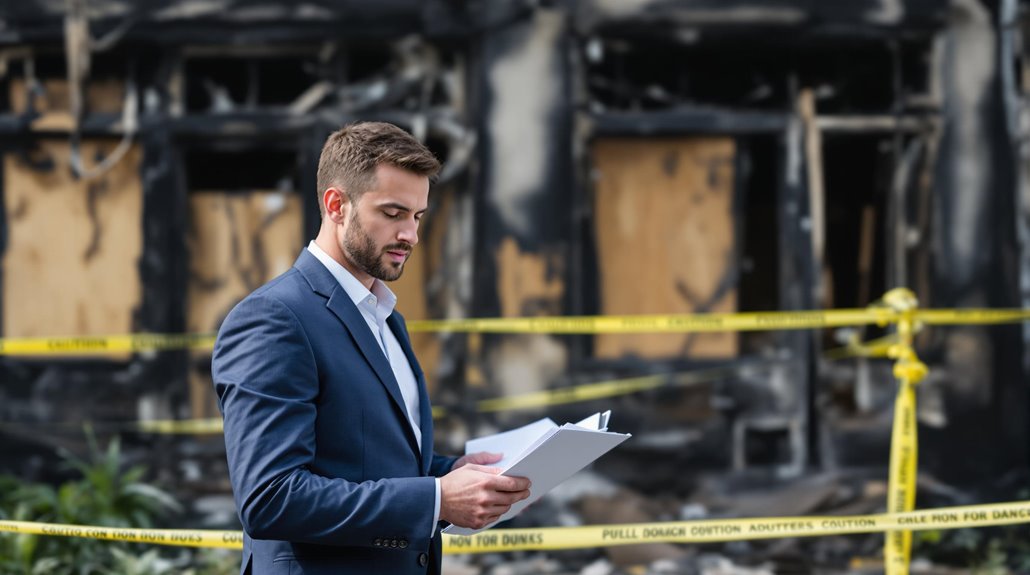
Numerous policyholders have found that hiring a public adjuster can be essential in ensuring a successful fire damage insurance claim. Public adjusters specialize in helping policyholders navigate the complexities of fire damage claims. With their extensive knowledge of insurance policies and claims processes, they identify all eligible losses and negotiate fair compensation.
While contingency fees range from 5-20% of the final settlement, they often deliver significant value by maximizing claim payouts.
| Benefits | Description | Impact on Policyholder |
|---|---|---|
| Expert Knowledge | Public adjusters possess an in-depth understanding of insurance policies | Accurate assessments of damage |
| Stress Reduction | Handle communications and gather documentation on behalf of policyholder | Reduced emotional burden |
| Financial Accessibility | Work on a contingency fee basis, payment as a percentage of the settlement | Affordable services |
| Increased Settlements | Studies show 20% to 30% higher settlements with public adjusters | Fair compensation |
Final Thoughts
Fire damage insurance claims require meticulous attention to detail and a thorough understanding of policy coverage. According to the National Fire Protection Association, a fire occurs in a U.S. home every 93 seconds, resulting in an estimated $11.6 billion in property damage annually. By following the essential steps outlined in this guide, policyholders can confidently navigate the complex claims process, ensuring a swift and hassle-free recovery from the devastating effects of a fire.
Frequently Asked Questions
How Do I Claim Damage Due to Fire?
Amidst the charred remains, a thorough claims process unfolds. To claim damage due to fire, one must promptly contact their insurance company, gather documentation, and meticulously record losses, securing the property and submitting a detailed claim.
What Is the 80% Rule Regarding Fire Insurance?
The 80% rule in fire insurance requires insuring a property for at least 80% of its total replacement value to receive full replacement cost coverage, preventing underinsurance and potential out-of-pocket expenses in case of a claim.
What Not to Say to an Insurance Claim Adjuster?
Disclosing too much can be detrimental. Statements implying fault, negligence, or exaggerating damages should be avoided when speaking with insurance claim adjusters and discussing prior claims or accepting settlements without thorough review.
How to Deal With Insurance Companies After a Fire?
When dealing with insurance companies after a fire, it is essential to document damages meticulously, maintain open communication with the adjuster, understand policy coverage and limits, and consider hiring a public adjuster if disputes arise to maximize the settlement.
